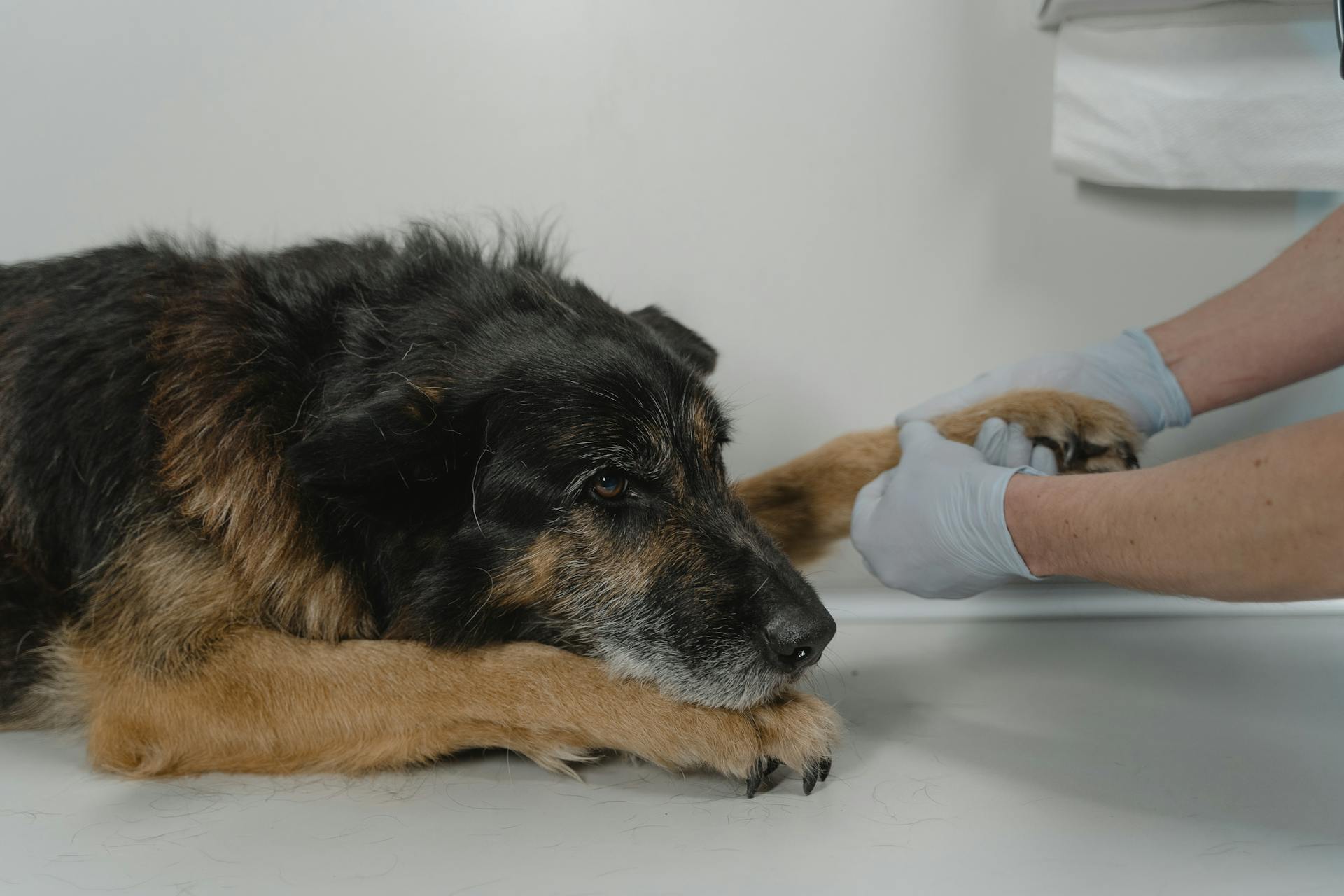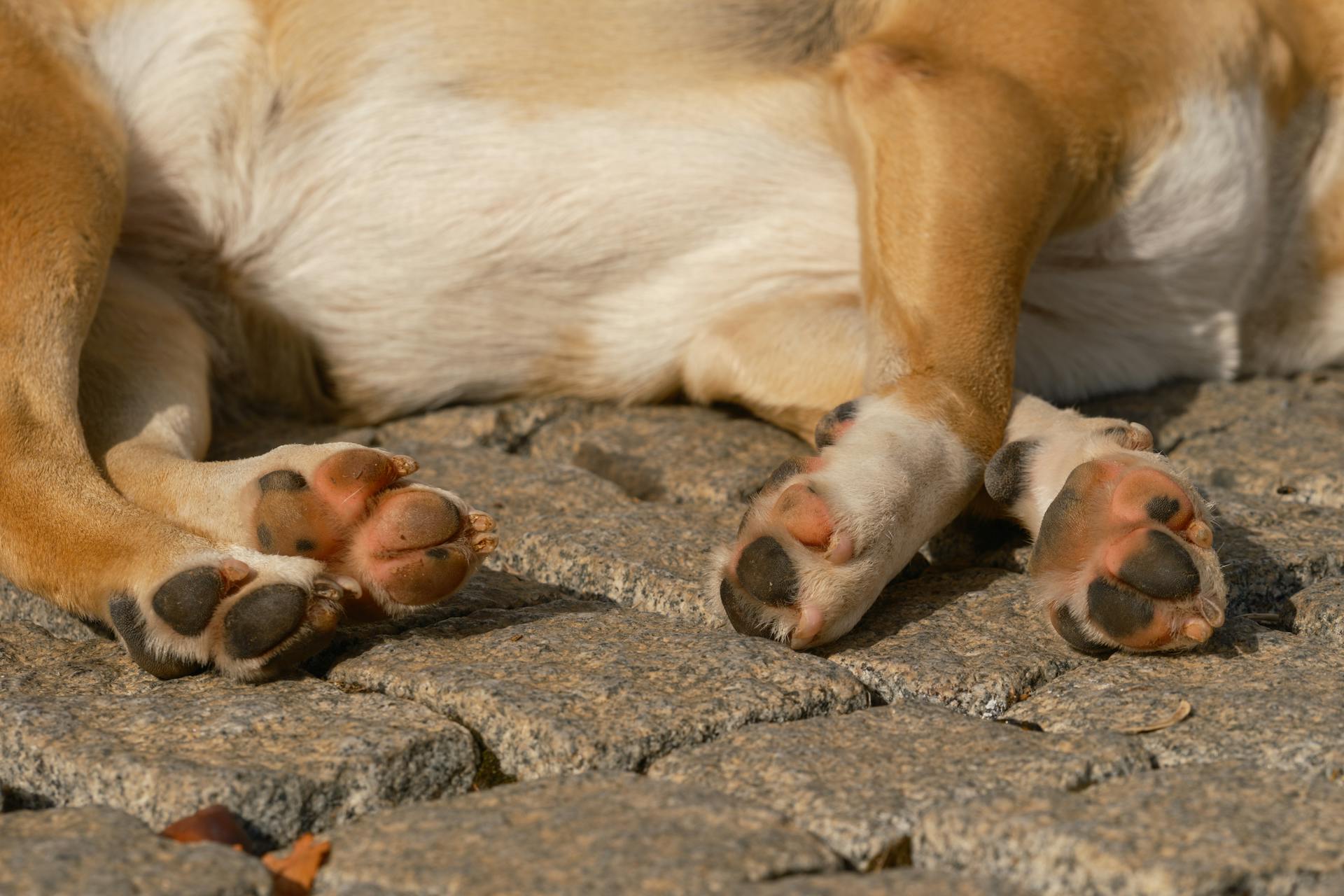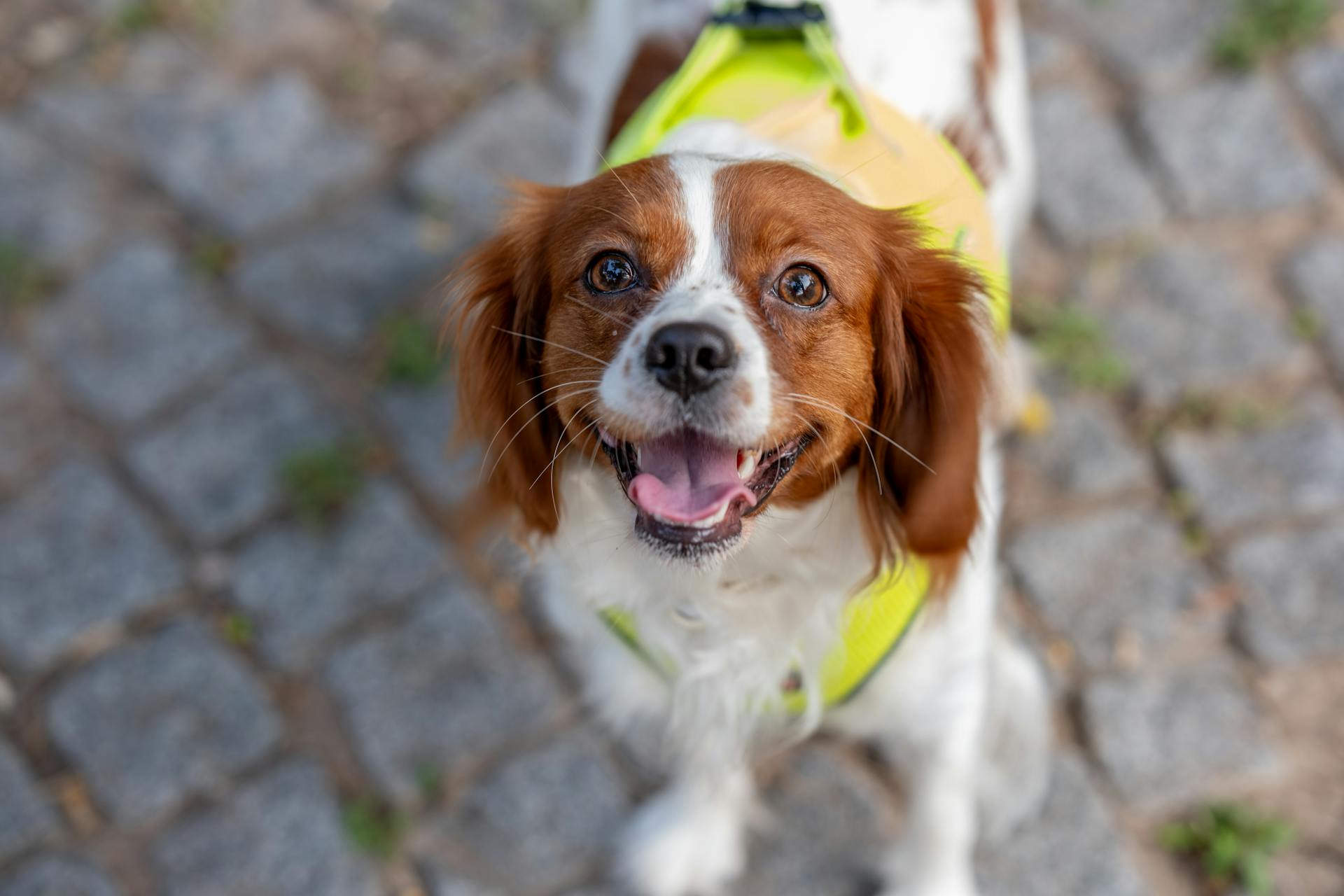
The pads on a dog's paw are made of a thick layer of skin that helps to distribute their weight and provide cushioning with each step. These pads can be quite thick, especially on the underside of the paw.
The toes on a dog's paw are actually made up of individual bones called phalanges, which are connected by joints that allow for flexibility and movement. Each toe has a small bone at the base called a metacarpal bone, which connects to the phalanges.
The dewclaw, a small nail-like structure on the inside of a dog's paw, can be removed surgically to prevent injuries or infections. Some breeds of dog are born without dewclaws altogether.
The pads on a dog's paw are also home to a network of nerve endings that help the dog feel its surroundings, including texture, temperature, and pressure. This helps the dog navigate its environment with ease.
Curious to learn more? Check out: Why Are Chihuahuas so Small
Canine Paw Anatomy
The dog paw has five basic parts: the claw, digital pads, metacarpal (on the front paws) and metatarsal (on the rear paws) pad, dew claw, and carpal pad.
The metacarpal, metatarsal, and digital pads function as the load-bearing, shock-absorbing pads to protect the joints and bones in your dog's paws. They're covered in thick skin that also helps with skid and traction on a slope or while stopping.
Dogs commonly have dewclaws on their front two paws, but not all do.
Expand your knowledge: Canine Paw Pad Anatomy
Dewclaws
Dewclaws are a unique feature of canine anatomy, found on the inside of a dog's front leg, near the wrist area. They're often referred to as the fifth nail.
Some dogs have dewclaws only on their front feet, while others may not have any at all. Extra dewclaws on the back feet can be more prone to getting caught or broken because they're often only attached by skin.
Dewclaws can assist with traction and balance, and are also used to help grip things that a dog is holding between its paws. They're more likely to get snagged on things and broken than the other claws.
Expand your knowledge: Lundehund Toes
Most breeds have dewclaws that are attached by bone, but some breeds like the Briard and the Great Pyrenees can have two dewclaws on each paw, with the extra one only attached by skin. This can make them more susceptible to injury.
Dewclaws need to be checked and trimmed regularly to prevent them from becoming too long. They don't get worn down naturally like the other claws do, so it's essential to keep an eye on them.
A unique perspective: Breeds of Dogs with Rear Dew Claws
Understanding Anatomy
A dog's paw has five basic parts: the claw, digital pads, metacarpal and metatarsal pad, dew claw, and carpal pad.
The metacarpal and metatarsal pads are the main load-bearing, shock-absorbing pads that protect the joints and bones in a dog's paws. They're covered in thick skin that helps with traction on various surfaces.
The metacarpal pad is located on the front paws and the metatarsal pad is on the rear paws, and they both contain fatty tissue that cushions and protects the bones of the paw.
On a similar theme: Canine Foot Anatomy
Dogs can sweat through their paw pads to release body heat, and scent-producing glands are present on the foot pad and between a dog's toes, which are believed to be a form of canine communication and used in marking territory.
The paw pads are also responsible for providing traction, helping dogs maintain a firm grip on different surfaces and preventing slips and falls.
Dogs have a unique way of walking, using their toes to bear weight, which is made possible by the fatty adipose tissue in their paw pads.
The dew claw is a mysterious part of a dog's anatomy, and its purpose is still debated, although it's believed to have been more useful in historical dog breeds.
Not all dogs have dew claws, and some breeds may have them on their front or rear legs, but it's common for breeders to remove them shortly after birth.
The carpal pad is located above the dew claw on a dog's front paws and aids in balance, while the tarsal pad is rare and found on a dog's back legs.
Each paw pad contains fatty tissue that acts as a shock absorber, protecting the paw from harsh weather and rough terrain.
Recommended read: Dog Foot Odor
A dog's toenails attach to the paw at the nail bed and are horn-shaped, starting out rounder and wider at the nail bed and getting narrower and more pointed towards the tip.
The hard outer shell of a toenail is made of keratin, and the soft quick inside the nail is sensitive to pain.
Curious to learn more? Check out: Canine Nail Anatomy
Paw Shapes and Types
Paw shapes can vary significantly between breeds, and each shape has its unique characteristics. Some breeds, like the Bull Terrier, Old English Sheepdog, and Akita, have paws that aid in balance, agility, and stability.
The Great Pyrenees and Great Dane have distinct paw types that were adapted for their original breeding purposes. The Great Pyrenees has webbed paws to navigate diverse terrain, while the Great Dane has hare feet similar to a rabbit's foot, prioritizing speed.
Compact, rounded paws, often referred to as "cat-like" paws, are found in breeds like the Doberman Pinscher. These dogs are bred to highlight strength and endurance.
The Different Shapes

Some dog breeds have a paw shape that aids in balance, agility, and stability. This shape is commonly found in breeds like Bull Terriers, Old English Sheepdogs, and Akitas.
Bull Terriers, for example, have a paw shape that is well-suited for their energetic and agile nature.
Hare-like
Hare-like paws are a unique feature found in the world's fastest dog breeds. The greyhound and the whippet are two examples of breeds that have hare-like paws.
Their paws have two long central "toes" and a relatively wide separation between the digital pads, which enables them to cover ground quickly. This adaptation allows them to run fast, but they can't sustain long distances due to energy burn.
Hare-like paws are a result of their original breeding purpose, prioritizing speed over endurance. This is evident in their large paws, which are designed to facilitate quick movement.
Cat-like
Cat-like paws are compact and rounded, a trait found in breeds like Doberman pinschers. These dogs are often bred to emphasize strength and endurance.
This type of paw shape is not unique to Doberman pinschers, as many breeds share this characteristic.
How to Care for Your
Taking care of your dog's paws is crucial for their overall health and well-being. Regularly inspect your dog's paws for any signs of injury or irritation, and clean the area with a mild antiseptic if needed.
You should also keep your dog's paw pads moisturized, especially during extreme weather conditions. Apply a paw balm or moisturizer specifically formulated for dogs to prevent dryness and cracking.
Trim your dog's nails regularly to prevent overgrowth, which can cause discomfort and affect their gait. If you're unsure, consult a professional groomer or veterinarian for guidance.
Protect your dog's paws from extreme temperatures. In hot weather, avoid walking them on scorching pavement that can burn their paw pads. During colder months, provide booties or use pet-safe paw wax to protect against frostbite and ice melt chemicals.
Here are some tips for creating a clean and safe environment for your dog to walk and play:
- Regularly sweep or mop floors to remove debris that can cause discomfort or injury
- Ensure the area is free from sharp objects, toxic plants, or other hazards that can harm their paws
Paw Anatomy and Function
A dog's paw is a marvel of nature, perfectly designed to support their weight and facilitate movement. It's made up of multiple bones, including the metacarpals and phalanges, which give the paw its shape and allow for flexibility and dexterity.
Ligaments connect and stabilize the paw, playing a crucial role in maintaining stability while running, jumping, and performing various activities. These strong, fibrous tissues hold bones together and provide support during movement.
The paw also has muscles that give it strength and enable movement. Dogs have numerous muscles in their paws, each serving a specific function, and these muscles work together to control the movement of the paw.
Dog paw anatomy reveals that the paw pads are made up of fatty tissue and are covered with a tough outer layer of skin, acting as shock absorbers to provide cushioning and protection. This unique structure allows dogs to walk and run for long periods without experiencing pain or fatigue.
The metacarpal, metatarsal, and digital pads function as the load-bearing, shock-absorbing pads to protect the joints and bones in your dog's paws. They're covered in thick skin that also helps with skid and traction on a slope or while stopping.
The claws provide traction and help a dog dig, and are made of a tough protein called keratin, similar to our fingernails. Not all dogs have dew claws, but for those that do, they can be on the front legs or, less commonly, on the rear legs.
Explore further: Do German Shepherds Have Dew Claws
The Claws
Each dog's toe has a toenail (claw) associated with it, which is used for traction, scratching, digging, and holding.
Claws typically curve slightly and point forward towards a dog's head, except for the dewclaws.
The outer shell of a claw is made of keratin, which can be clear or black.
The inner core of a claw contains blood vessels and nerves, known as the quick.
This inner core is the part that hurts and bleeds if you cut a nail too short.
Structure and Function
A dog's paw is a marvel of nature, perfectly designed to support their weight and facilitate movement. The bones at the core of a dog's paw provide structure and support, with each paw consisting of multiple bones, including the metacarpals and phalanges, equivalent to the human hand and fingers.
These bones give the paw its shape and allow for flexibility and dexterity. Ligaments, strong fibrous tissues, connect and stabilize the paw, playing a crucial role in maintaining stability while running, jumping, and performing various activities.
Dogs have numerous muscles in their paws, each serving a specific function, that work together to control the movement of the paw. These muscles give the paw strength and enable movement, allowing dogs to walk, run, and even manipulate objects with their feet.
The paw pads act as shock absorbers, providing cushioning and protection, helping dogs walk on various surfaces without discomfort. The paw pads are made up of fatty tissue and covered with a tough outer layer of skin, allowing dogs to walk and run for long periods without experiencing pain or fatigue.
Claws or nails on a dog's paws are essential tools for digging, gripping, and maintaining balance. They are made of a tough protein called keratin, similar to human fingernails.
Sweat Glands
Dogs don't have sweat glands all over their bodies, but they do have them in specific areas, including their paw pads.
These sweat glands help regulate body temperature and cool down when dogs become overheated. They secrete a watery substance called sweat that evaporates and helps dissipate heat.
You may notice wet paw prints on the floor or ground when a dog is hot because of this sweat. It's a great way for dogs to cool down, especially in hot weather.
The sweat produced by the paw pads also contains pheromones, which are chemical substances that dogs use for communication. These pheromones can convey information about a dog's mood, reproductive status, and even their territory.
Dogs primarily rely on panting to regulate their body temperature, as they have a limited number of sweat glands on their paw pads.
Frequently Asked Questions
What should my dog's paw pads look like?
A healthy dog's paw pads should be smooth to the touch. If they're rough or dry, it's time to provide some moisturizing relief.
What is dog paw knuckling?
Dog paw knuckling is a neurological condition where a dog's paw bends under, causing them to walk on their knuckles instead of their pads. It's often a sign of a nervous system issue, such as injury, disease, or spinal cord degeneration.
What does a paw infection look like?
A paw infection typically presents with red, swollen feet or paws, accompanied by hair loss, nodules, ulcers, or discharge. If you suspect your dog has a paw infection, it's essential to seek veterinary care to prevent further complications.
What is the extra thing on a dog's paw?
The extra thing on a dog's paw is called a carpal pad, which is a growth above the front paws and sometimes on the back legs. This unusual feature serves a helpful purpose for dogs.
What is the high pad on a dog's paw?
The high pad on a dog's paw is called the carpal pad, which helps with traction and stopping. It's a smaller pad located above the main paw pads.
Featured Images: pexels.com


